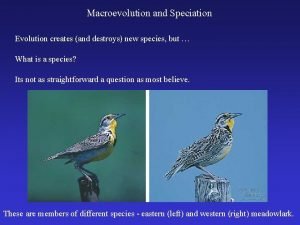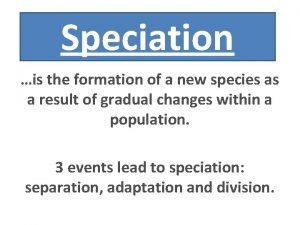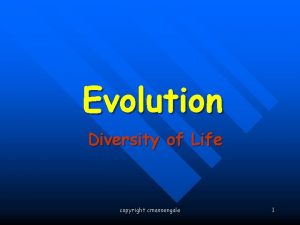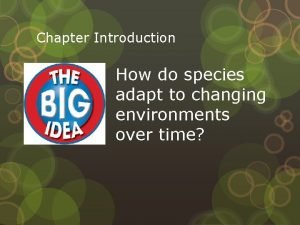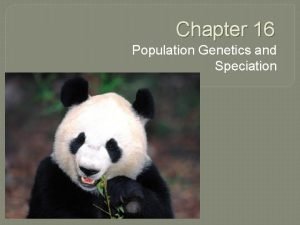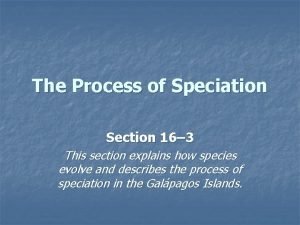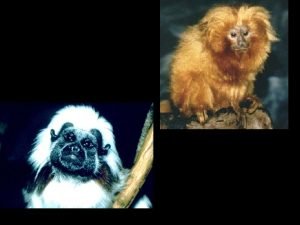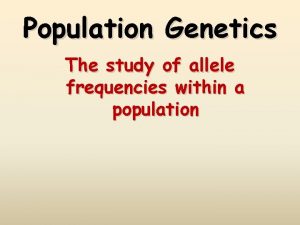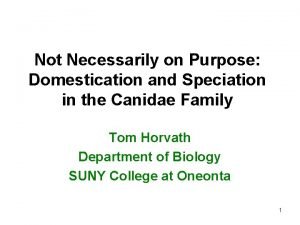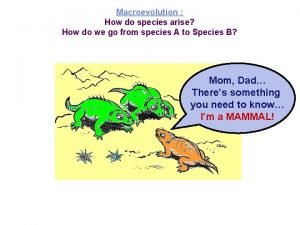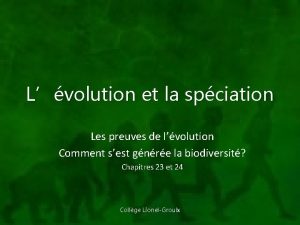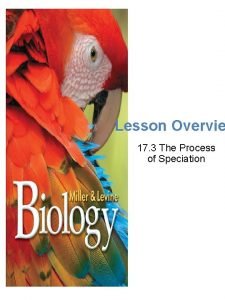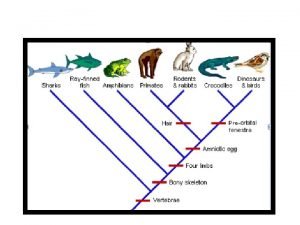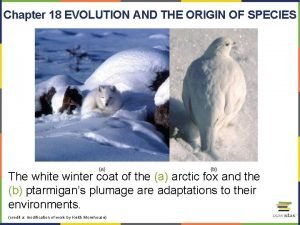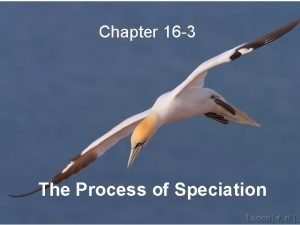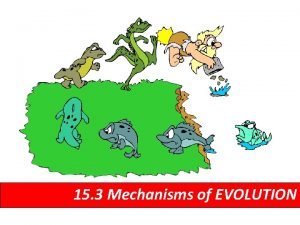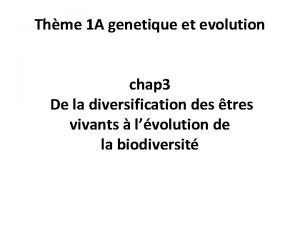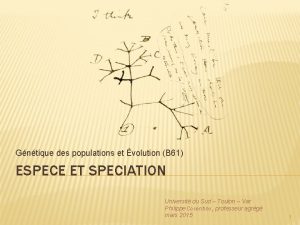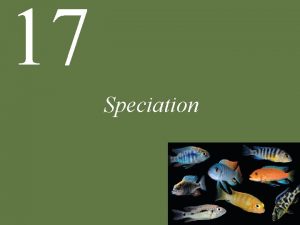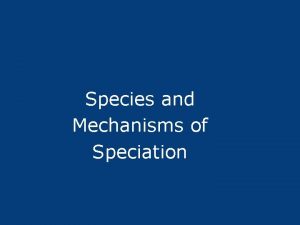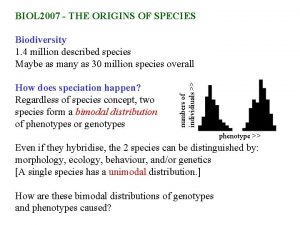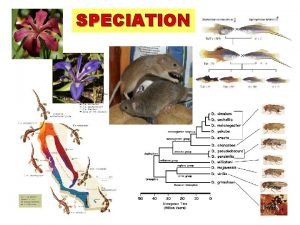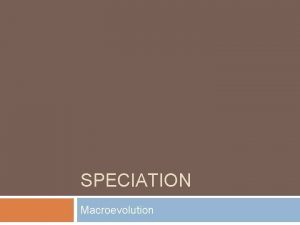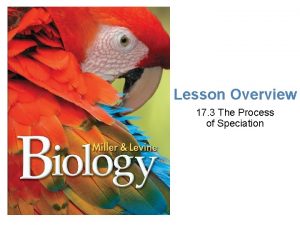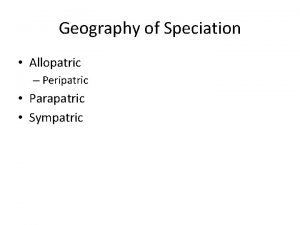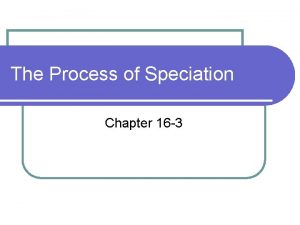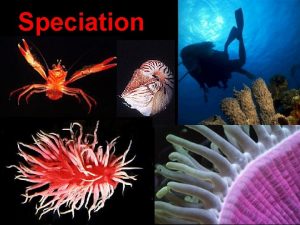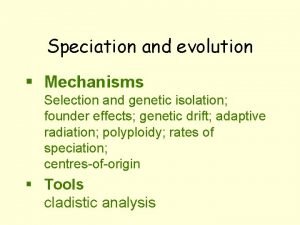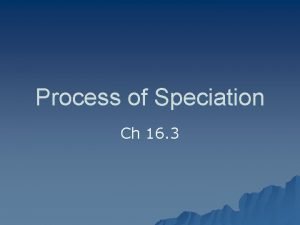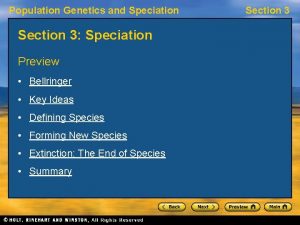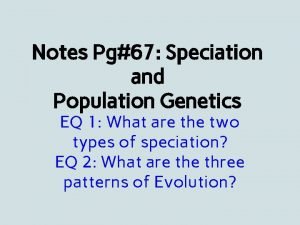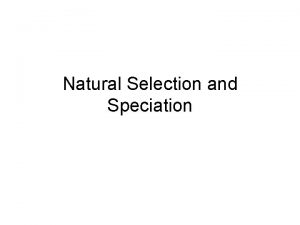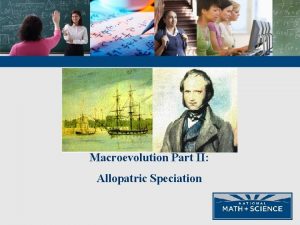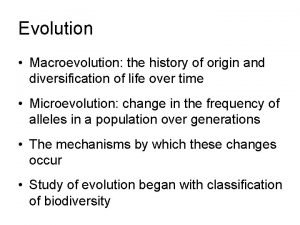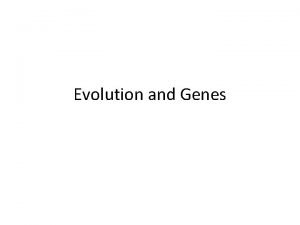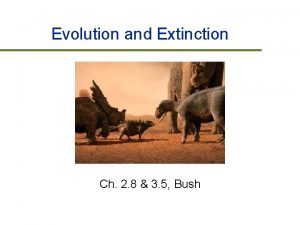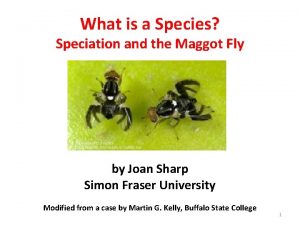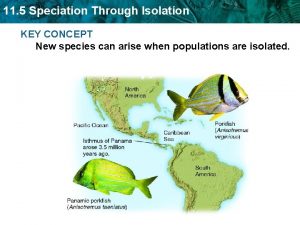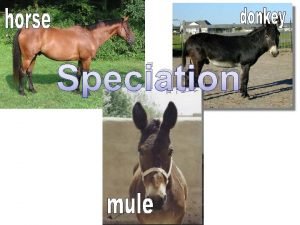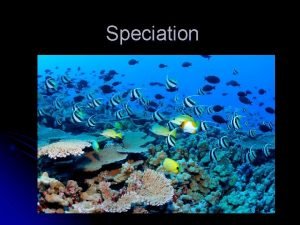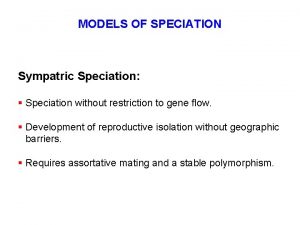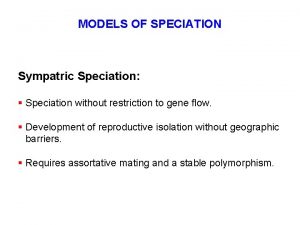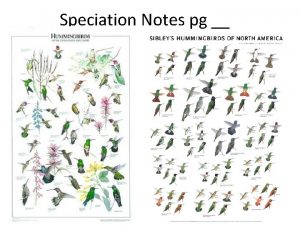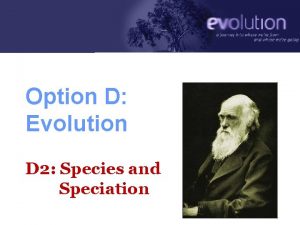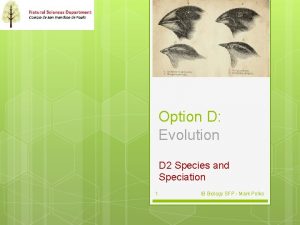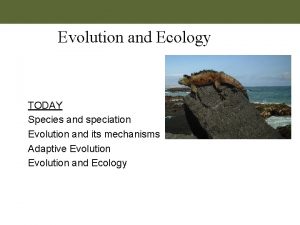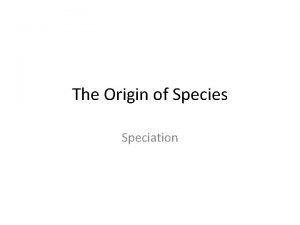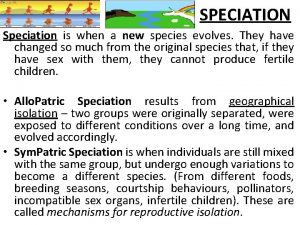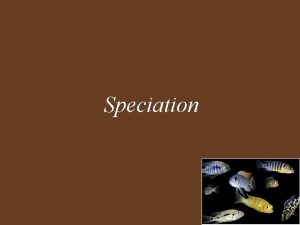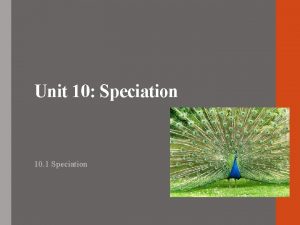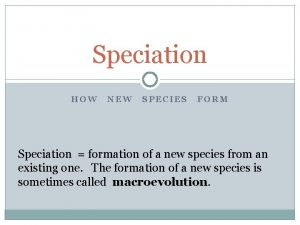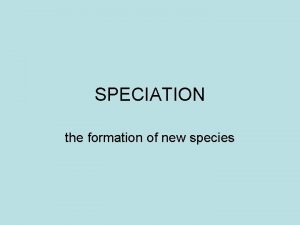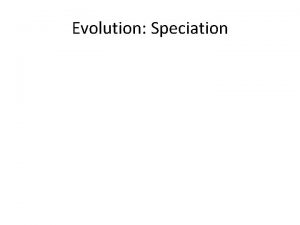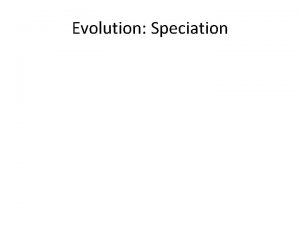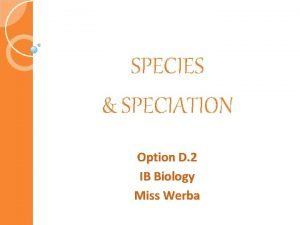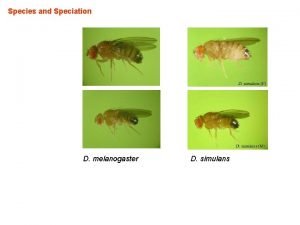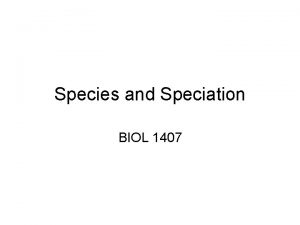Option D Evolution D 2 Species and Speciation



















































- Slides: 51

Option D: Evolution D 2: Species and Speciation

D 2. 1 Define allele frequency and gene pool. • gene pool – • allele frequency –

D 2. 2 State that evolution involves a change in allele frequency in a population’s gene pool over a number of generations. • Evolution of populations is best understood in terms of allele frequencies • If the allele frequencies remain constant from generation to generation, then the population is not undergoing any evolutionary change and is in • Evolution can be defined as (change in the genetic makeup of populations over time)

D 2. 3 Discuss the definition of the term species. • Biological species concept ▫ defined by Ernst Mayr ▫ population whose members can ▫ reproductively compatible Distinct species: songs & behaviors are different enough to prevent interbreeding Diverse, but same species Eastern Meadowlark Western Meadowlark

D 2. 4 Describe three examples of barriers between gene pools. • Species are created by a series of evolutionary processes ▫ populations become isolated – reduces gene flow geographically isolated reproductively isolated ▫ isolated populations evolve independently ▫ Gene flow = the migration of breeding individuals between populations causing a corresponding movement of alleles

D 2. 4 Describe three examples of barriers between gene pools. PRE-reproduction barriers - obstacle to mating or to fertilization if mating occurs geographic isolation behavioral isolation ecological isolation temporal isolation mechanical isolation gametic isolation

D 2. 4 Describe three examples of barriers between gene pools. Geographic isolation • Species occur in different areas ▫. ▫ allopatric speciation “other country” Harris’s antelope squirrel inhabits the canyon’s south rim (L). Just a few miles away on the north rim (R) lives the closely related white-tailed antelope squirrel

D 2. 4 Describe three examples of barriers between gene pools. Ecological isolation • Species occur in same region, but ▫ reproductively isolated 2 species of garter snake, Thamnophis, occur in same area, but one lives in water & other is terrestrial lions & tigers could hybridize, but they live in different habitats: § lions in grasslands § tigers in rainforest

D 2. 4 Describe three examples of barriers between gene pools. Temporal isolation • Species that breed ▫ reproductive isolation ▫ sympatric speciation “same country” Eastern spotted skunk (L) & western spotted skunk (R) overlap in range but eastern mates in late winter & western mates in late summer

D 2. 4 Describe three examples of barriers between gene pools. Behavioral isolation • Unique ▫ identifies members of species ▫ attract mates of same species courtship rituals, mating calls reproductive isolation Blue footed boobies mate only after a courtship display unique to their species Video clip of courtship: http: //www. youtube. com/watch? v=PL h. OKC 6 ZDp. I

Recognizing your own species courtship songs of sympatric species of lacewings courtship display of Gray-Crowned Cranes, Kenya http: //www. youtube. com/watch? v=lu. Vi. M 0 V-EI&feature=related firefly courtship displays

D 2. 4 Describe three examples of barriers between gene pools. Mechanical isolation • Morphological (form & structure) differences can prevent successful mating ▫ reproductive isolation Even in closely related species of plants, the flowers often have distinct appearances that attract different pollinators. These 2 species of monkey flower differ greatly in shape & color, therefore cross-pollination does not happen. Plants

D 2. 4 Describe three examples of barriers between gene pools. Mechanical isolation • For many insects, male & female sex organs of closely related species do not fit together, preventing sperm transfer Animals ▫ lack of “fit” between sexual organs: hard to imagine for us… but a big issue for insects with different shaped genitals! I can’t even imagine!

D 2. 4 Describe three examples of barriers between gene pools. Gametic isolation • Sperm of one species may not be able biochemical barrier so sperm cannot penetrate egg receptor recognition: lock & key between egg & sperm chemical incompatibility sperm cannot survive in female reproductive tract Sea urchins release sperm & eggs into surrounding waters where they fuse & form zygotes. Gametes of different species— red & purple —are unable to fuse.

D 2. 4 Describe three examples of barriers between gene pools. POST-reproduction barriers • Prevent hybrid offspring from developing into a ▫ reduced hybrid viability ▫ reduced hybrid fertility ▫ hybrid breakdown Horse + Zebra = Zebroid liger

D 2. 4 Describe three examples of barriers between gene pools. Reduced hybrid viability • Genes of different parent species may interact & impair the hybrid’s development Species of salamander genus, Ensatina, may interbreed, but most hybrids do not complete development & those that do are frail.

D 2. 4 Describe three examples of barriers between gene pools. Reduced hybrid fertility • Even if hybrids are vigorous, they may be sterile ▫ chromosomes of parents may differ in number or structure & meiosis in hybrids may fail to produce normal gametes Mules are vigorous, but sterile Horses have 64 chromosomes (32 pairs) Mules have 63 chromosomes! Donkeys have 62 chromosomes (31 pairs)

D 2. 4 Describe three examples of barriers between gene pools. Hybrid breakdown • Hybrids may be fertile & viable in first generation, but when they mate offspring are feeble or sterile In strains of cultivated rice, hybrids are vigorous but plants in next generation are small & sterile. On path to separate species.

D 2. 5 Explain how polyploidy can contribute to speciation. Changes in chromosome number may cause instantaneous speciation ▫ polyploidy – ▫ may occur when a fertilized egg duplicates its chromosomes but does not divide into two daughter cells – all subsequent divisions may be normal and all cells are now tetraploid

D 2. 5 Explain how polyploidy can contribute to speciation. ▫ caused by nondisjunction – ▫ most tetraploid plants are healthy and vigorous and can go through meiosis gametes produced can only – cannot fuse with gametes from original parents occurs in plants because plants can ▫ ▫ http: //www. youtube. com/watch? v=Sbr. Vw 1 jr. Zx. E

D 2. 5 Explain how polyploidy can contribute to speciation. • Autopolyploids (auto= self) are polyploids with multiple chromosome sets derived from a single species • Autopolyploids form following fusion of 2 n gametes

D 2. 5 Explain how polyploidy can contribute to speciation. • Autopolyploidy can be induced in plants using colchicine, a chemical extracted from the autumn crocus. • Autopolyploids with odd ploidys eg. triploid or pentaploid have trouble reproducing sexually • That does not stop them from being good crops if they can be propagated asexually Outcrossing – two plants Selfing – selffertilized Vegetative – asexual

D 2. 5 Explain how polyploidy can contribute to speciation. Allopolyploids (allo= different) come about when a sterile F 1 hybrid Wheat + = Rye Triticale For example, Triticale is the hybrid of wheat (Triticum For example, Triticale is the hybrid of turgidum) and rye (Secale wheat (Triticum turgidum) and rye cereale). It combines sought(Secale cereale). It combines soughtafter characteristics of the parents, but the initial hybrids were sterile until doubling of the number of were sterile until doubling of chromosomes occurred the number of chromosomes occurred

D 2. 6 Compare allopatric and sympatric speciation. • Species are created by a series of evolutionary processes ▫ populations become isolated geographically isolated reproductively isolated ▫ isolated populations evolve independently • Isolation ▫ Allopatric geographic separation ▫ Sympatric still live in same area

D 2. 6 Compare allopatric and sympatric speciation. • Allopatric speciation – speciation that occurs when • Most • Population evolves as a result of natural selection and/or genetic drift

D 2. 6 Compare allopatric and sympatric speciation. • Often results from physical isolation due to the constant changing of the earth’s surface • Ex. : river shifting course, glaciers migrating, mountain ranges forming, land bridges forming, etc.

D 2. 6 Compare allopatric and sympatric speciation. • Also results from a type of genetic drift called founders effect: • Genetic drift is • Founders effect occurs when a

Example of founders effect: Parent Population: red, yellow, black The new population is genetically different than the parent population.

D 2. 6 Compare allopatric and sympatric speciation. • Sympatric speciation - a new species develops • More common in • Usually results from: • Ecological isolation • Polyploidy

D 2. 7 Outline the process of adaptive radiation. Adaptive Radiation When a species gives rise to many new species in a relatively short period of time Typically occurs when populations of a

D 2. 7 Outline the process of adaptive radiation. Think Darwin’s finches (AGAIN!) They originated from a population of an ancestral species that flew or were blown to the Galapagos islands from mainland South America. They colonized the islands and (while geographically isolated) evolved via natural selection to have beaks that suited the types of food available on their islands. ee fin Tr nd ch es Bud eater ou fin c he s er Warbl finch Cactus eater Insect eaters Seed eaters Gr Their beaks are homologous structures in that they have evolved from a common structure to have different functions.

D 2. 7 Outline the process of adaptive radiation. Seed eaters Flower eaters Insect eaters Rapid speciation: new species filling new niches because they inherited successful adaptations. Adaptive radiation

D 2. 7 Outline the process of adaptive radiation. Darwin’s finches • Differences in beaks ▫ associated with eating different foods ▫ survival & reproduction of beneficial adaptations to foods available on islands Warbler finch Cactus finch Woodpecker finch he fin c ee fin Medium ground finch ch Tr nd es Bud eater ou Vegetarian tree finch Small ground finch Gr Large insectivorous tree finch er Warbl finch Cactus eater Insect eaters Seed eaters s Small insectivorous tree finch Sharp-beaked finch Large ground

D 2. 7 Outline the process of adaptive radiation. Darwin’s finches • Darwin’s conclusions ▫ small populations of original South American finches landed on islands variation in beaks enabled individuals to ▫ over many generations, the populations of finches changed anatomically & behaviorally accumulation of advantageous traits in population emergence of

D 2. 8 Compare convergent and divergent evolution. Convergent evolution describes evolution towards . Other (random!) examples include: - Penguins in the southern hemisphere and Auks in the northern hemisphere both use wings as flippers - Echolocation in bats, toothed whales and shrews to capture prey. - Flight/gliding in birds, pterosaurs, bats, insects and flying fish! Little Auk http: //commons. wikimedia. org/wiki/File: Alle_2. jp g Little Penguin http: //commons. wikimedia. org/wiki/File: Little_penguin_Eudyptula_minor. jpg

D 2. 8 Compare convergent and divergent evolution. Features that come about by convergent evolution are known as

D 2. 8 Compare convergent and divergent evolution. Divergent evolution describes evolution towards . Divergent Evolution is another way of saying (D. 2. 7). As natural selection acts on two or more species that have arisen from a common ancestor, they become phenotypically different.

D 2. 8 Compare convergent and divergent evolution. It gives rise to , features that now look different or have a different purpose for each species that has evolved

D 2. 9 Discuss ideas on the pace of evolution, including gradualism and punctuated equilibrium. Gradualism • Gradual divergence over long spans of time ▫ assume that big changes occur as the accumulation of many small ones

D 2. 9 Discuss ideas on the pace of evolution, including gradualism and punctuated equilibrium. Punctuated Equilibrium • Rate of speciation is not constant ▫. ▫ long periods of little or no change ▫ species undergo rapid change when they 1 st bud from parent population Time

D 2. 9 Discuss ideas on the pace of evolution, including gradualism and punctuated equilibrium. Revisiting the tree for punctuated equilibrium it should be noted that the “sudden” speciation events are only sudden in terms of geological time. They would still take many generations and possibly thousands of years. The periods of stasis may be explained by stabilizing selection. The punctuation could be explained by directional selection or disruptive selection.

After Before D 2. 9 Discuss ideas on the pace of evolution, including gradualism and punctuated equilibrium. The downward facing arrows indicate selection pressure against individuals with that morphology All images CC Andrew Colvin

Coevolution • Occurs when • Examples include predators and prey and organisms that live in symbiotic relationships (mutualism, commensalism, parasitism) As one evolves a new feature or modifies an old one, the other typically evolves new adaptations in response • Stinging ant & the acacia plant Ant stings insects that try to eat the plant, plant provides food in the form of nectar & shelter in the form of thorns

D 2. 10 Describe one example of transient polymorphism. Polymorphism is the (Poly = “many”; morphism = “shapes”) Transient Polymorphism is • ex: peppered moth melanism Prior to 1840 peppered moths in Britain were light grey with dark spots to blend in with the grey lichen that grew on the trees in their habitat

D 2. 10 Describe one example of transient polymorphism. The first dark variant was reported in 1848 and by 1895 most of them were black. The term industrial melanism was coined. Soot and acid rain from the burning of coal changed the color of the trees that the moths rested on. Directional selection did the rest. Ø Draw a graph of what that might look like. http: //www. flickr. com/photos/naturalhistoryman/81733298

D 2. 10 Describe one example of transient polymorphism. Before long the majority were dark. This situation reversed after 1956 when Britain instituted the clean air act. Less coal was burnt and most trees returned to their original colour. Now in polluted areas most moths are dark and in rural areas most moths are light. They are not distinct species because they still interbreed. The theory that natural selection due to predation was the cause of these changes has been confirmed experimentally by Dr HBD Kettlewell

D 2. 11 Describe sickle cell anemia as an example of balanced polymorphism. Balanced Polymorphism • Two alleles are maintained in stable equilibrium • Heterozygote has Sickle cell anaemia occurs when a single-base mutation in the gene that codes for haemoglobin causes the amino acid valine to be produced in a particular spot rather than glutamic acid.

D 2. 11 Describe sickle cell anemia as an example of balanced polymorphism. Valine is non-polar, unlike glutamic acid, and this causes the mutant variety of haemoglobin (haemoglobin S) to crystallise at low concentrations of oxygen. This in turn pulls the red blood cell into a sickle shape. It is less able to carry oxygen and can get stuck in small capillaries, causing blockages, pain and damage. Homozygous individuals (Hb. S) are subject to a debilitating condition and have a shortened life expectancy

D 2. 11 Describe sickle cell anemia as an example of balanced polymorphism. On the brighter side, while individuals who are heterozygous (Hb. A Hb. S) will have some mutant haemoglobin. They can lead normal lives. As a benefit, they are resistant to malaria as the plasmodium parasite that causes it is not able to use sickle cells to reproduce. Individuals that are homozygous normal (Hb. A) have no sickle cells and no resistance to malaria. http: //www. pbs. org/wgbh/evolution/library/01/2/l_012_02. html Historical distribution of malaria Distribution of the sickle cell trait

Heterozyg ous: Sickle cell trait A S A A Homozygo us: ‘Normal’ 25% chance A S A S Heterozygou s: Sickle cell trait 50% chance S S Homozygous : Sickle Anaemia 25% chance Hb. A Haemoglobin: Normal RBCs: Normal O 2 Capacity: Normal Malaria resistance: None Hb. A Hb. S Haemoglobin: 50% normal, 50% mutant RBCs: Usually normal, sickle when [O 2] low O 2 Capacity: Mild anaemia Malaria resistance: Moderate Hb. S Haemoglobin: mutant RBCs: Sickle O 2 Capacity: Severe anaemia Malaria Resistance: High http: //en. wikipedia. org/wiki/File: Autorecessiv e. svg

D 2. 11 Describe sickle cell anemia as an example of balanced polymorphism. People who are homozygous for sickle cell are severely anemic and have less chance of surviving to reproduce. Likewise individuals homozygous for normal hemoglobin are likely to contract malaria and are less likely to survive. Heterozygous individuals have what is termed . They are the most likely to survive and reproduce. Therefore both alleles are maintained in the population
 Antelope squirrel allopatric speciation
Antelope squirrel allopatric speciation Speciation or the formation of new species is
Speciation or the formation of new species is Soal pilihan ganda (multiple choice)
Soal pilihan ganda (multiple choice) Option terminology
Option terminology Define keystone species in biology
Define keystone species in biology Geographic distribution of species evolution
Geographic distribution of species evolution Evolution of species 2
Evolution of species 2 Population genetics and speciation worksheet answer key
Population genetics and speciation worksheet answer key Section 16-3 the process of speciation
Section 16-3 the process of speciation Speciation
Speciation Horizontal gene transfer
Horizontal gene transfer Allopatric speciation example
Allopatric speciation example Genetics
Genetics Artificial speciation
Artificial speciation Hybrid fertility
Hybrid fertility La spéciation
La spéciation Process of speciation
Process of speciation Speciation
Speciation Ecological speciation
Ecological speciation The origin of species 18
The origin of species 18 16-3 the process of speciation
16-3 the process of speciation Sympatric species
Sympatric species Lecointre
Lecointre Scala naturae
Scala naturae Embryo development
Embryo development Speciation
Speciation Sympatric speciation example
Sympatric speciation example Parapatric speciation
Parapatric speciation Ring species
Ring species Speciation process
Speciation process Speciation process
Speciation process Parapatric speciation
Parapatric speciation Sympatric speciation
Sympatric speciation Section 16-3 the process of speciation
Section 16-3 the process of speciation Speciation scenarios reinforcement answer key
Speciation scenarios reinforcement answer key Parapatric speciation
Parapatric speciation Speciation
Speciation 16-3 the process of speciation
16-3 the process of speciation Modes of speciation ppt
Modes of speciation ppt Genetic drift
Genetic drift Directional selection
Directional selection Example of mechanical isolation
Example of mechanical isolation Speciation
Speciation Parapatric speciation
Parapatric speciation Modes of speciation ppt
Modes of speciation ppt Speciation can only be observed over millions of years
Speciation can only be observed over millions of years Speciation through isolation
Speciation through isolation Circle the correct option to complete the sentences
Circle the correct option to complete the sentences Read the sentences and circle the correct option
Read the sentences and circle the correct option Spot forward rate formula
Spot forward rate formula Vbscript
Vbscript Flex lexer generator
Flex lexer generator
